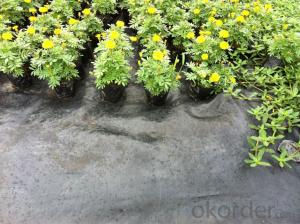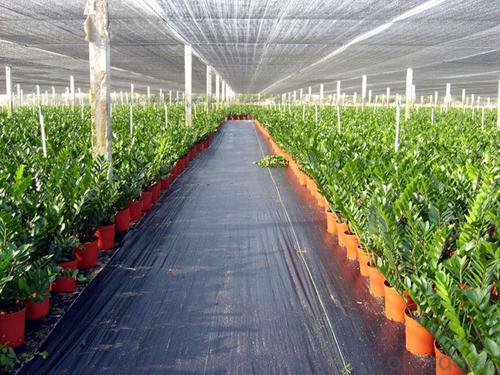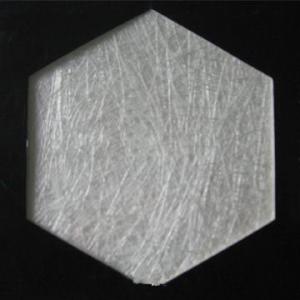4 Oz Non-Woven Geotextile Filter Fabric for Construction and Landscaping
- Loading Port:
- China main port
- Payment Terms:
- TT OR LC
- Min Order Qty:
- 5000 m²
- Supply Capability:
- 1000000 m²/month
OKorder Service Pledge
OKorder Financial Service
You Might Also Like
Landscape Geotextile Introduction
Landscape Geotextiles are composed from synthetic polypropylene/polyester fibres through a mechanical process of needling the fabric and adding, when necessary, a thermo fused process, resulting in a uniform porous structure with excellent tensile strength and chemical deterioration.
Type: 1. Wovens & knitted: use various fibre types in different combinations.
2. Non-wovens: staple or continuous fibres that are heat treated or needlepunched to “fix” fibres relative to each other.


Landscape Geotextile Specification
1) Weight / Mass: 75g/m2-400g/m2 .
2) Width: Within 8 m (1m-8m)
3) Length: 50m-100m/roll (as request)
4) Material: PP
5) Color: Black , white , grey, others
6) The biggest geotextile manufacturer/factory in China for many years . The equipment is introduced from Germany.
7) This geotextile can be made of polypropylene (PP).
8) The mass is available from 75g/m2 to 400g/m2 and the width available from 1.0m-8m, monolayer or multilayer (reinforcement geotextiles), long fiber or short fiber.
9) Color: all kinds of color are available. The annual production ability is 10 million square meters.
10) The fabric can also be heat treated by infrared at customer's requirements. Our geotextile are UV stabilized to give protection against aging under exposure to natural ultra-violet light.


PP Geotextile Application
1) Filtration
The filtration layer of the dykes, river canal, seacoast, concrete slope, retaining walls. At the same time of preventing the clay granule from passing, it allows the water and the gas pass through freely.
2) Separation:
The isolation of the railway dregs and the roadbed, roadbed and the soft base, surface of the airdrome and parking lot and the groundsill, different dam materials. It isolates the soil and the gravel of two kinds different granule pathway from the groundsill or other buildings.
3 )Reinforcement:
The highway, railway, soil-stone dam, breakwater, airport, backfill soil of retaining wall, slope protection, etc in which distributes the earth stress, prevents the side-displacement of the earth body and improves the earth body stability.
4 )Protection
It prevents the bank from being washed out, protects the bank and the bottom, prevents the water and soil from being washed away.
FAQ:
Q1: What is your minimum order quantity?
A:The minimum order quantity is 5000 ,but it is negotiable.
Q2:What is your payment terms?
A: T/T,Western Union,Paypal,L/C...
Waiting to cooperate with you!
- Q: Production of geomembrane equipment which are such as the production of geotextile need to press machine, open charter, carding machine, etc.
- Mixing machine, screw extruder, heating die, circulating fan, traction machine, into a roll machine.
- Q: Fish tank white filter cotton toxic, is not geotextile, or non-woven Yeah
- No toxic, geotextile and non-woven raw materials are polyester, chemical name PET, its normal situation is not toxic, if the heating temperature reaches 117 degrees, will precipitate some chemical substances, when the fish may have an impact. But your water temperature will not reach 117 degrees, unless you want to drink fish soup, so there is no problem
- Q: How do geotextiles help with erosion control in slope protection projects?
- Geotextiles help with erosion control in slope protection projects by providing a physical barrier that prevents soil erosion. They are placed on the surface of slopes to stabilize the soil, allowing vegetation to grow and establish roots. This helps in reducing the impact of rainfall and surface flow, minimizing sediment runoff, and maintaining the integrity of the slope. Additionally, geotextiles enhance the overall stability of the slope by distributing loads and reinforcing the soil, thereby reducing the risk of slope failure.
- Q: How do geotextiles help with load distribution in bridge approach fills?
- Geotextiles help with load distribution in bridge approach fills by providing a reinforcement layer that distributes the load from the bridge structure more evenly across the fill material. This helps to prevent differential settlement and ensures the stability and durability of the bridge approach.
- Q: Filament, preferably concrete construction
- Tianhai new material filament geotextile case analysis of water conservancy projects: seawall, river embankment, lake embankment project; reservoir reinforcement project; reclamation project; flood control and rescue. Highway and railway engineering: soft foundation reinforcement treatment; slope protection; road anti-reflective crack structure layer; drainage system; green isolation zone. Electrical engineering: nuclear power plant basic engineering; thermal ash dam project; hydropower project.
- Q: Pudong Chuansha where to sell geotextiles
- Geotextile, also known as geotextile, it is made of synthetic fiber through acupuncture or woven from the permeability of geosynthetics. Geotextile is a new material geosynthetics which one, the finished product for the cloth, the general width of 4-6 meters, the length of 50-100 meters. Geotextile is divided into a spinning geotextile and non-woven filament geotextile. Use geotextile, letter, welcome
- Q: What are the different factors to consider for geotextile selection in mining applications?
- When selecting geotextiles for mining applications, several factors need to be considered. These include the required strength and durability of the geotextile to withstand the specific mining conditions, such as heavy machinery, abrasion, and chemical exposure. The permeability and filtration capabilities of the geotextile are also crucial to ensure proper drainage and prevent clogging. Additionally, factors like installation ease, cost-effectiveness, and compliance with environmental regulations should be taken into account to make an informed decision for geotextile selection in mining applications.
- Q: Geotextile price geotextile how much money a square meter
- Woven geotextile: 1.20-8.50 yuan / square meter filament geotextile: 1.60-9.60 yuan / square meter staple geotextile: 1.20-9.80 yuan / square meters impervious geotextile: 3.60-28.0 yuan / square meter geotextile is A new type of building materials, raw materials are polyester, polypropylene, acrylic, nylon and other polymer polymer synthetic fiber. In accordance with the manufacturing method is divided into: there are two types of geotextile and non-woven geotextile. According to the use of anti-seepage, anti-filter, drainage, isolation, reinforcement, protection, sealing, etc. a variety of functions, based on a variety of factors, the price is not the same
- Q: Geotextile (two cloth a film) to detect the frequency requirements? On behalf of the number?
- Geotextile and geomembrane detection frequency is 100 volumes detection time.
- Q: Polyester filament nonwoven is filament geotextile
- Yes, generally do geotextile material, polyester filament nonwoven fabric refers to filament geotextile. Huazhi geotechnical materials manufacturers to answer your questions
Send your message to us
4 Oz Non-Woven Geotextile Filter Fabric for Construction and Landscaping
- Loading Port:
- China main port
- Payment Terms:
- TT OR LC
- Min Order Qty:
- 5000 m²
- Supply Capability:
- 1000000 m²/month
OKorder Service Pledge
OKorder Financial Service
Similar products
Hot products
Hot Searches
Related keywords


































